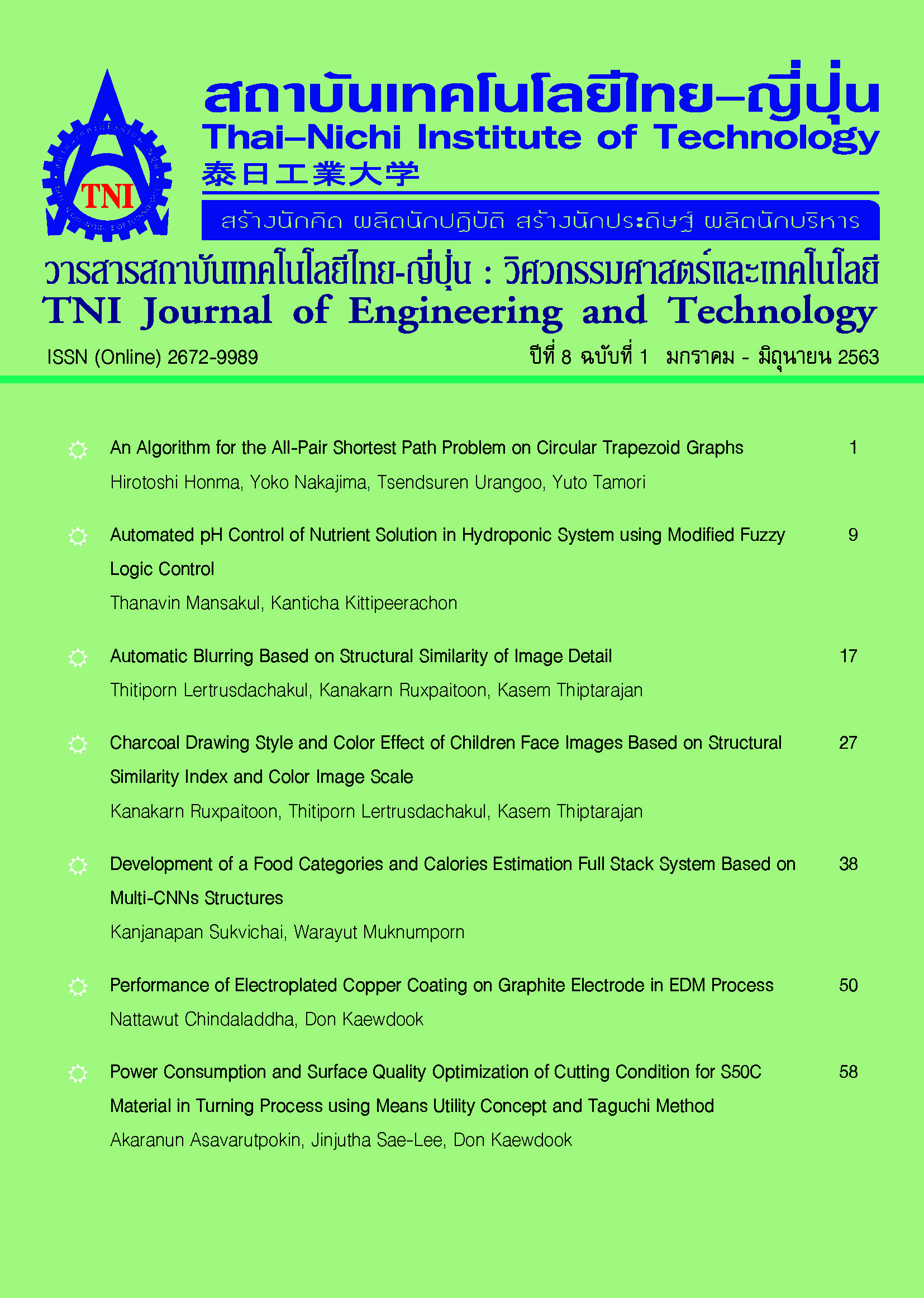Development of A Food Categories and Calories Estimation Full Stack System Based on Multi-CNNs Structures
Main Article Content
บทคัดย่อ
Humans require different food amounts and nutrition depended on age, gender and health. Amount of food intake can create health problems especially for infants, elderly or diabetics. Tradition nutrition booklet is not suitable for most people since it is hard to understand. Thai-foods are hard to extract the nutrition and most of the Thai dishes are not in the book since it focused on Western dishes. This research focused on development on a full stack AI system that categorizes Thai-food dishes, classifies and localizes the ingredients in each dish and estimate nutrition and calories. Multi-Convolutional Neural Networks (CNNs) are used to achieve these categorize, classify and localize tasks. The designed system is separated into AI backend and Mobile application frontend based on OpenCV in an Android smartphone. MobileNet is used as a food categorizer while You-Only-Look-Once (YOLO) network works as the ingredient’s classifier and localizer. Then, ingredients in the pictures are cropped and passed through traditional image processing algorithm with predetermined parameters to calculate and transformed pixel into real-dimension area referenced by Thai coins. Pixel area of non-uniform shape ingredients are segmented and the nutrition and calories can be estimated via a standard reference lookup table. Full stack system is developed in this research based on RESTful protocol with JSON format that used to communicate between a smartphone and AI server. The designed CNNs and full stack system are trained, tested, verified and deployed then the food image captured from a smartphone application can be used to estimated nutrition and calories. Finally, useful information is display on a smartphone screen.
Article Details
นโยบายการรับบทความ
กองบรรณาธิการวารสารสถาบันเทคโนโลยีไทย-ญี่ปุ่น มีความยินดีรับบทความจากอาจารย์ประจำ และผู้ทรงคุณวุฒิในสาขาวิศวกรรมศาสตร์และเทคโนโลยี ที่เขียนเป็นภาษาไทยหรือภาษาอังกฤษ ซึ่งผลงานวิชาการที่ส่งมาขอตีพิมพ์ต้องไม่เคยเผยแพร่ในสิ่งพิมพ์อื่นใดมาก่อน และต้องไม่อยู่ในระหว่างการพิจารณาของวารสารอื่นที่นำส่ง ดังนั้นผู้สนใจที่จะร่วมเผยแพร่ผลงานและความรู้ที่ศึกษามาสามารถนำส่งบทความได้ที่กองบรรณาธิการเพื่อเสนอต่อคณะกรรมการกลั่นกรองบทความพิจารณาจัดพิมพ์ในวารสารต่อไป ทั้งนี้บทความที่สามารถเผยแพร่ได้ประกอบด้วยบทความวิจัย ผู้สนใจสามารถศึกษาและจัดเตรียมบทความจากคำแนะนำสำหรับผู้เขียนบทความ
การละเมิดลิขสิทธิ์ถือเป็นความรับผิดชอบของผู้ส่งบทความโดยตรง บทความที่ได้รับการตีพิมพ์ต้องผ่านการพิจารณากลั่นกรองคุณภาพจากผู้ทรงคุณวุฒิและได้รับความเห็นชอบจากกองบรรณาธิการ
ข้อความที่ปรากฏภายในบทความของแต่ละบทความที่ตีพิมพ์ในวารสารวิชาการเล่มนี้ เป็น ความคิดเห็นส่วนตัวของผู้เขียนแต่ละท่าน ไม่เกี่ยวข้องกับสถาบันเทคโนโลยีไทย-ญี่ปุ่น และคณาจารย์ท่านอื่น ๆ ในสถาบัน แต่อย่างใด ความรับผิดชอบด้านเนื้อหาและการตรวจร่างบทความแต่ละบทความเป็นของผู้เขียนแต่ละท่าน หากมีความผิดพลาดใด ๆ ผู้เขียนแต่ละท่านจะต้องรับผิดชอบบทความของตนเองแต่ผู้เดียว
กองบรรณาธิการขอสงวนสิทธิ์มิให้นำเนื้อหา ทัศนะ หรือข้อคิดเห็นใด ๆ ของบทความในวารสารสถาบันเทคโนโลยีไทย-ญี่ปุ่น ไปเผยแพร่ก่อนได้รับอนุญาตจากผู้นิพนธ์ อย่างเป็นลายลักษณ์อักษร ผลงานที่ได้รับการตีพิมพ์ถือเป็นลิขสิทธิ์ของวารสารสถาบันเทคโนโลยีไทย-ญี่ปุ่น
ผู้ประสงค์จะส่งบทความเพื่อตีพิมพ์ในวารสารวิชาการ สถาบันเทคโนโลยีไทย-ญี่ปุ่น สามารถส่ง Online ที่ https://www.tci-thaijo.org/index.php/TNIJournal/ โปรดสมัครสมาชิก (Register) โดยกรอกรายละเอียดให้ครบถ้วนหากต้องการสอบถามข้อมูลเพิ่มเติมที่
- กองบรรณาธิการ วารสารสถาบันเทคโนโลยีไทย-ญี่ปุ่น
- ฝ่ายวิจัยและนวัตกรรม สถาบันเทคโนโลยีไทย-ญี่ปุ่น
เลขที่ 1771/1 สถาบันเทคโนโลยีไทย-ญี่ปุ่น ซอยพัฒนาการ 37-39 ถนนพัฒนาการ แขวงสวนหลวง เขตสวนหลวง กรุงเทพมหานคร 10250 ติดต่อกับคุณพิมพ์รต พิพัฒนกุล (02) 763-2752 , คุณจุฑามาศ ประสพสันติ์ (02) 763-2600 Ext. 2402 Fax. (02) 763-2754 หรือ E-mail: JEDT@tni.ac.th
References
J. Wardle, K. Parmenter, and J. Waller, “Nutrition knowledge and food intake,” Appetite, vol. 34, no. 3, pp. 269–275, Jun. 2000, doi: 10.1006/appe.1999.0311.
T. Waratornpaibul, “Consumption behavior: consumerism food and health-conscious food,” Panyapiwat Journal, vol. 5 no. 2, pp. 255-264, Oct. 2015.
C. Szegedy et al., “Going deeper with convolutions,” in 2015 IEEE Conf. on Computer Vision and Pattern Recognition (CVPR), Boston, MA, Oct. 2015, pp. 1-9.
X. Xia, C. Xu, and B. Nan, “Inception-v3 for flower classification,” in 2017 2nd International Conf. on Image, Vision and Computing (ICIVC), Chengdu, Jun. 2017, pp. 783-787.
A. Krizhevsky, I. Sutskever, and G. E. Hinton, “ImageNet classification with deep convolutional neural networks,” in Proc. 25th International Conf. on Neural Information Processing Systems (NIPS’12), Tahoe, NV, USA, 2012, pp. 1097-1105.
M. Abadi, et al., “TensorFlow: A system for large-scale machine learning,” in Proc. 12th USENIX conference on Operating Systems Design and Implementation (OSDI’16), Savannah, GA, USA, Nov. 2016, pp. 265–283.
R. Joseph, D. Santosh, G. Ross, and F. Ali., “You only look once: Unified, real-time object detection,” in 2016 IEEE Conference on Computer Vision and Pattern Recognition (CVPR), Las Vegas, NV, USA, 2016, pp. 779-788.
J. Redmon and A. Farhadi, “YOLOv3: An incremental improvement,” Apr. 2018. [Online]. Available: arXiv:1804.02767.
S. Boonvisut, Nutritive values of Thai foods, Bangkok, Thailand: Nutrition Division, the Department of Health Ministry of Public Health (in Thai), 2001.
K. He, G. Gkioxari, P. Dollár, and R. Girshick, “Mask R-CNN,” in 2017 IEEE International Conf. on Computer Vision (ICCV), Venice, Italy, Oct. 2017, pp. 2980-2988.
D. Bolya, C. Zhou, F. Xiao, and Y. J. Lee, “YOLACT: Real-time instance segmentation,” Oct. 2019. [Online]. Available: arXiv:1904.02689.

